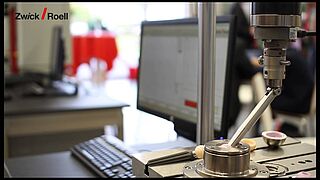ASTM F1820: Scope and requirements
ASTM F1820-13: Standard Test Method for Determining the Forces for Disassembly of Modular Acetabular Devices
The test methods specified in ASTM F1820 can be used to determine the mechanical stability between the acetabular shell and liner or inserts, and various insert locking mechanisms can be compared.
The standard describes three different test methods:
- Axial push-out
The acetabular shell with liner is attached to a test fixture with the opening of the shell facing down. The insert is then pressed out of the acetabular shell. This requires a hole to be drilled in the pole. The resulting force is recorded. - Offset pullout or lever out
The acetabular shell with liner is attached to a fixture with the opening facing up. An off-center tensile force is then applied to the liner via a rod, which releases the liner from the acetabular shell. As and alternative, the lever out method using a lever arm is also permitted. The lever out test can also be performed as a dynamic test with up to five million load cycles. - Torque out disassembly
This test requires a femoral head that is attached or bonded to the insert in at least four evenly spaced locations. Torque is then applied to the liner through the head along the pole axis until the insert detaches.
